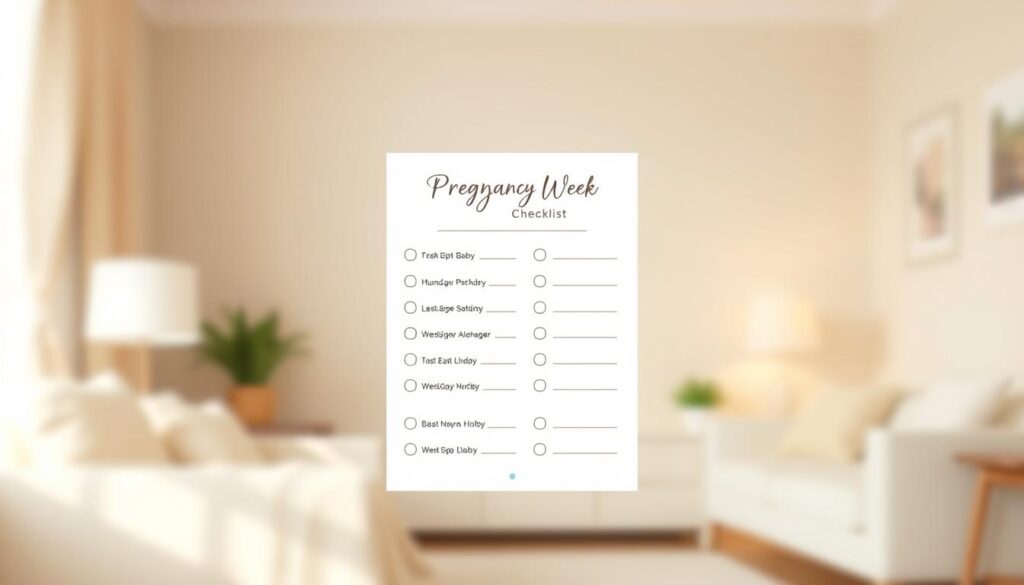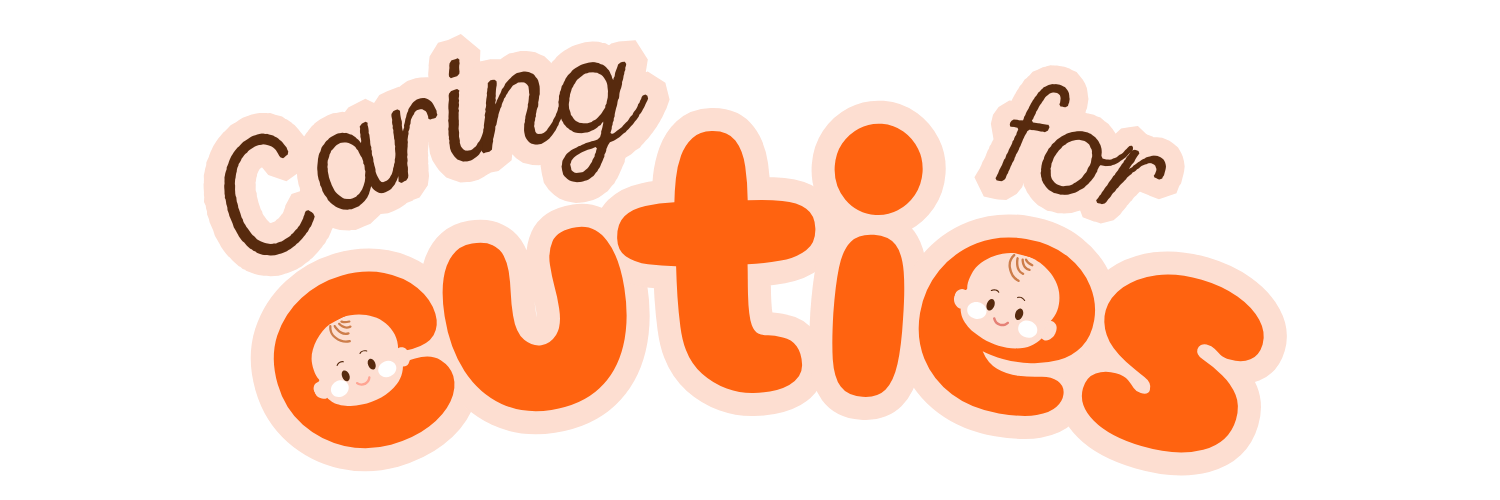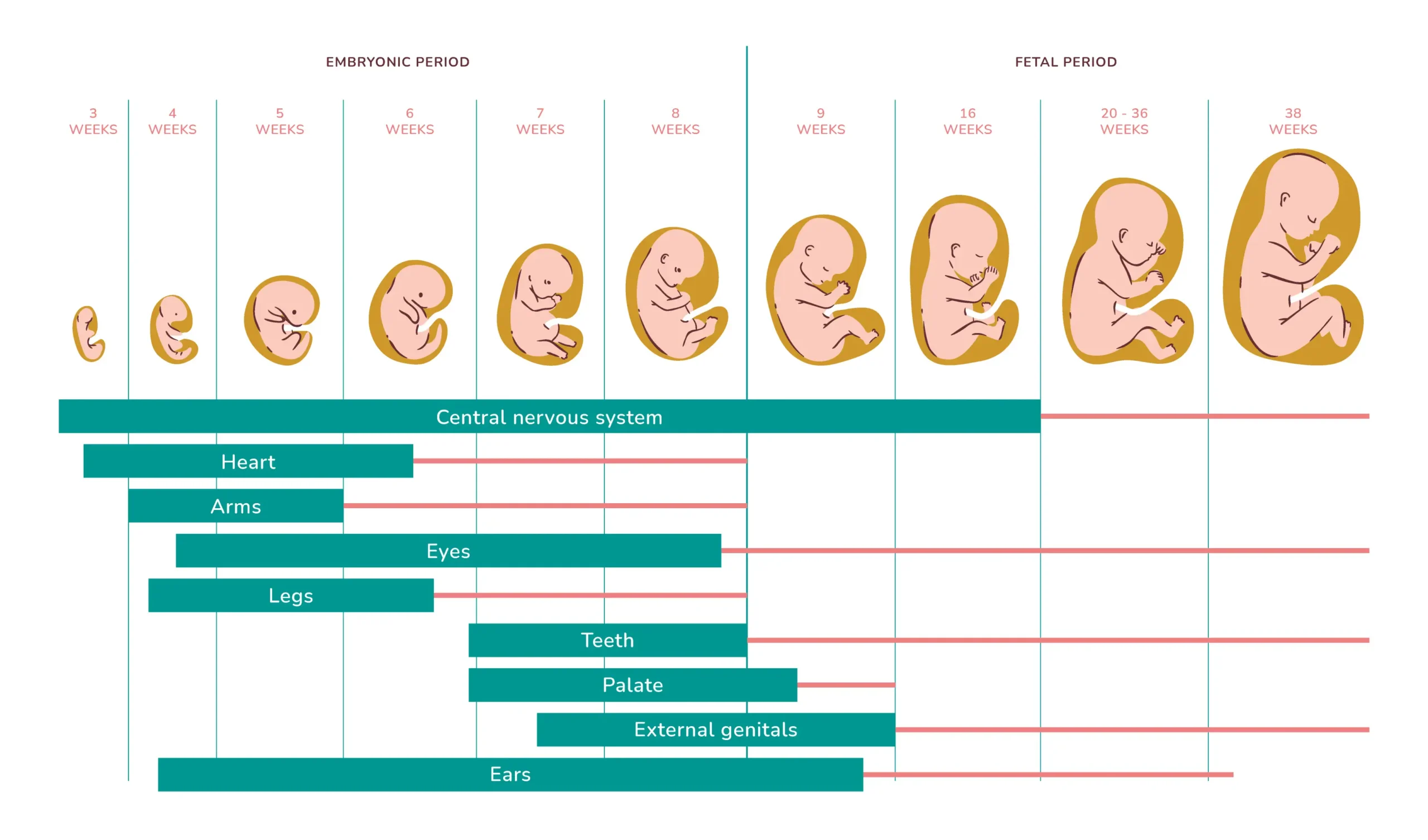Becoming a mom is one of the most transformative experiences in life. From the moment you find out you’re expecting, every day brings new changes—both for your baby and your body. Staying informed and organized can make this journey smoother and more enjoyable.

A pregnancy week by week checklist is an essential tool for every mom-to-be. It helps you track your baby’s growth, monitor physical changes, and stay on top of important milestones. Whether it’s your first trimester or the final stretch of the third trimester, this guide ensures you’re prepared for every step.
With expert advice, interactive videos, and easy-to-follow infographics, this checklist simplifies the process. It also helps you schedule prenatal visits, track developmental changes, and plan for the big day. Being well-informed not only reduces stress but also empowers you to make the best decisions for you and your baby.
Key Takeaways
- Track your baby’s growth and your body’s changes with a detailed checklist.
- Stay organized with prenatal visits and important milestones.
- Access expert advice and interactive resources for each stage.
- Simplify planning from the first trimester to birth with a clear timeline.
- Feel confident and prepared throughout your pregnancy journey.
Understanding Your Pregnancy Journey
Embarking on the journey of motherhood brings a series of unforgettable moments and changes. From the first signs to the final stages, this experience is a blend of growth and discovery. Understanding the timeline helps in navigating its challenges and joys.
Your Pregnancy Timeline: Milestones and Moments
Every month brings new developments for both you and your baby. In the early stages, you might notice subtle changes in your body. As time progresses, these shifts become more pronounced. For example, by the third trimester, your baby’s growth accelerates, and your skin may stretch to accommodate this change.
Interactive timelines and visual aids from trusted resources can help you track these milestones. They also assist in planning medical visits and lifestyle adjustments. Staying informed ensures you’re prepared for each step of this transformative journey.
How Pregnancy Transforms Your Body and Life
This journey is not just about physical changes; it’s a complete life transformation. Your body adapts to support your baby’s growth, and your daily routine may shift to accommodate new needs. Emotional well-being is equally important, as hormonal changes can impact your mood.
Timely check-ups are crucial to monitor these changes. They help ensure both you and your baby are healthy. By understanding these transformations, you can embrace this journey with confidence and clarity.
Your Complete Guide to pregnancy week by week
Understanding each stage of this journey helps you stay organized and informed. A week-by-week overview ensures you’re prepared for every milestone, from early signs to the final stages. This guide provides a clear roadmap for both you and your baby.

What to Expect: A Week-by-Week Overview
Each week brings new developments for you and your baby. In the early stages, you might notice subtle changes in your body. As time progresses, these shifts become more pronounced. By the third trimester, your baby’s growth accelerates, and your skin may stretch to accommodate this change.
Here’s what you can expect:
- First Month: Early signs like fatigue and morning sickness may appear.
- Second Month: Your baby’s heartbeat becomes detectable.
- Third Month: The first ultrasound reveals your baby’s growth.
- Third Trimester: Prepare for birth by tracking weekly changes.
Tracking each week helps you plan prenatal visits and make informed healthcare decisions. It also prepares you for the physical and emotional changes common during this time. For example, your body adapts to support your baby’s growth, and your daily routine may shift to accommodate new needs.
Practical advice, such as marking your due date on the calendar, ensures you’re ready for the big day. A systematic overview empowers you to make the best decisions for you and your baby.
Trimesters Explored: First, Second, and Third Stages
The journey of motherhood is divided into three distinct phases, each with its own unique challenges and milestones. These trimesters guide you through the physical and emotional changes that come with growing a new life. Understanding each stage helps you stay prepared and confident.
First Trimester: Early Development and Signs
The first trimester is a time of rapid development for your baby. During this stage, you might experience early signs like fatigue, morning sickness, and mood swings. Your body begins to adapt to support the growing life inside you.
Key milestones include the formation of vital organs and the first detectable heartbeat. Regular check-ups are essential to monitor progress and ensure everything is on track. This is also the time to start planning for the months ahead.
Second Trimester: Baby’s Growth & Mom’s Changes
The second trimester is often called the “honeymoon phase” of pregnancy. Your baby grows rapidly, and you might start feeling their movements. Your body continues to change, with your skin stretching to accommodate the growing baby.
This is a great time to focus on self-care and prepare for the final stages. Many moms find this period more comfortable, with fewer symptoms like nausea. It’s also the ideal time to schedule important scans and tests.
Third Trimester: Pre-Birth Preparations
The final trimester is all about preparation. Your baby is almost ready for birth, and your body is making final adjustments. You might experience increased fatigue, Braxton Hicks contractions, and nesting instincts.
Use this time to finalize your birth plan, pack your hospital bag, and ensure everything is ready for the big day. Regular check-ups become more frequent to monitor your baby’s position and health. Staying informed and organized helps reduce stress as you approach your due date.
Each trimester brings its own set of challenges and joys. By understanding these stages, you can navigate your journey with confidence and clarity.
Monitoring Your Baby’s Growth and Development
Tracking your baby’s growth week by week is an exciting and essential part of the journey. Each stage brings new milestones, from the first heartbeat to the final preparations for birth. Staying informed helps you ensure your baby is developing as expected.

Week-by-Week Baby Growth Milestones
Every week, your baby undergoes significant changes. In the early stages, the focus is on the formation of vital organs. By the second trimester, your baby’s size increases rapidly, and you may start feeling their movements.
Here’s a breakdown of key developmental milestones:
- Week 8: The heartbeat becomes detectable.
- Week 12: Major organs are formed, and the first ultrasound is conducted.
- Week 20: Your baby’s movements are noticeable, and gender can often be determined.
- Week 32: Rapid growth continues, and your baby prepares for birth.
Using growth charts and checklists can help you monitor these changes. Regular check-ups ensure your baby’s development aligns with expectations. If any irregularities are detected, early intervention can make a significant difference.
| Week | Milestone | Key Indicators |
|---|---|---|
| 8 | Heartbeat Detected | First ultrasound, organ formation |
| 12 | Major Organs Formed | First trimester screening |
| 20 | Noticeable Movements | Anatomy scan, gender determination |
| 32 | Rapid Growth | Final preparations for birth |
An organized checklist ensures you don’t miss any important milestones. It also helps you track your baby’s size and weight, providing peace of mind as you approach your due date. By staying informed, you can confidently navigate this transformative journey.
Physical and Emotional Changes: What Moms Can Expect
The journey to motherhood brings a mix of physical and emotional changes that shape your experience. From shifts in your body to fluctuations in mood, understanding these transformations helps you navigate this time with confidence.
Body Changes and Weight Considerations
Your body undergoes significant changes to support your growing baby. Weight gain is a natural part of this process, but it’s important to monitor it healthily. Your skin may stretch, and you might notice changes in texture or elasticity.
Here are some common physical changes to expect:
- Increased weight as your baby grows.
- Stretching of the skin, sometimes leading to stretch marks.
- Changes in posture and body shape to accommodate your baby’s size.
Staying active and maintaining a balanced diet can help manage these changes. Regular check-ups ensure your body is adapting as expected.
Emotional Well-being and Mental Health
Emotional well-being is just as important as physical health. Hormonal changes can impact your mood, leading to stress or anxiety. Being aware of these shifts helps you take proactive steps to maintain mental health.
Here are some tips to support your emotional well-being:
- Practice mindfulness or meditation to reduce stress.
- Stay connected with loved ones for emotional support.
- Get enough sleep to help regulate mood and energy levels.
If you feel overwhelmed, don’t hesitate to seek professional help. Emotional health is a crucial part of preparing for your due date and beyond.
By understanding both physical and emotional changes, you can embrace this journey with confidence and clarity. Awareness of these signals ensures you’re ready for each step ahead.
Creating Your Ultimate Pregnancy Checklist
A personalized checklist is your best companion for staying organized during this transformative time. It helps you track important milestones, appointments, and changes in your body and your baby’s development. Here’s how to create one that works for you.
Start by listing key appointments and tests. Include prenatal visits, ultrasounds, and screenings. Tracking these ensures you don’t miss critical check-ups. Use digital tools like apps or calendars to set reminders and stay on schedule.
Next, add weekly milestones to monitor your baby’s growth. For example, note when the heartbeat becomes detectable or when movements start. This helps you stay informed and connected to your baby’s progress.
Don’t forget to include first trimester indicators like fatigue or morning sickness. Tracking these symptoms can help you manage them better. Also, note changes in your skin or weight to stay aware of your body’s adaptations.
Here’s a step-by-step guide to building your checklist:
- Track Appointments: Schedule prenatal visits, ultrasounds, and tests.
- Monitor Milestones: Note key developments like the first heartbeat or movements.
- Record Symptoms: Track changes in your body and mood.
- Plan for Birth: Include tasks like packing a hospital bag and finalizing your birth plan.
Adapt your checklist as you progress. For example, in the first trimester, focus on early signs and appointments. By the third trimester, shift to preparing for birth and tracking your due date.
Using infographics or digital tools can make your checklist more engaging. They provide visual aids for tracking your baby’s size and development. Staying organized reduces stress and ensures you’re ready for each step.
| Stage | Focus Areas | Tools |
|---|---|---|
| First Trimester | Early signs, appointments | Digital calendars, apps |
| Second Trimester | Baby’s growth, symptoms | Infographics, checklists |
| Third Trimester | Birth preparation, due date | Hospital bag checklist, birth plan |
By creating a detailed checklist, you’ll feel more in control and prepared for this journey. It’s a simple yet powerful way to stay organized and reduce stress.
Staying Informed with Week-by-Week Tips and Insights
Expert advice and actionable tips can make this experience smoother and more manageable. Staying informed about weekly changes helps you adapt to the physical and emotional shifts during this period. With curated insights, you can navigate each stage with confidence.
Expert Tips for a Healthy and Informed Journey
Nutrition, exercise, and self-care are essential components of a healthy routine. Experts recommend focusing on balanced meals rich in vitamins and minerals. Regular physical activity, like walking or prenatal yoga, supports your body and reduces stress.
Here are some actionable tips to consider:
- Track Weekly Changes: Use apps or journals to monitor your baby’s growth and your body’s adaptations.
- Stay Hydrated: Drinking enough water supports your skin elasticity and overall health.
- Prioritize Rest: Adequate sleep helps manage weight and improves mood.
Understanding bodily signals is crucial. For example, fatigue in the first trimester is common, while increased size in the later stages may require adjustments in posture. Reliable resources like blogs and videos provide up-to-date information to guide you.
| Week | Focus Area | Expert Tip |
|---|---|---|
| 1-12 | Early Development | Focus on folic acid intake for your baby’s neural development. |
| 13-27 | Mid-Stage Growth | Incorporate light exercises to maintain body strength. |
| 28-40 | Final Preparations | Practice breathing techniques for labor and monitor your due date closely. |
Interactive tools, such as apps and online communities, encourage active engagement. They provide a platform to ask questions and share experiences. By staying proactive, you can address challenges effectively and enjoy this transformative journey.
Understanding Common Pregnancy Symptoms
Recognizing and understanding common symptoms can help you feel more in control. From early signs to late-stage changes, your body undergoes a lot of transformations. Being aware of what’s normal and what’s not can ease your mind during this time.

Recognizing Signs & When to Seek Help
In the first trimester, you might experience fatigue, nausea, or mood swings. These are typical as your body adjusts to support your growing baby. However, severe symptoms like persistent vomiting or sharp pain should prompt a call to your healthcare provider.
As you progress into the second and third trimesters, symptoms like back pain, swelling, and skin changes may appear. While these are common, sudden swelling in your hands or face could indicate a more serious condition. Always consult your doctor if you’re unsure.
Here’s a breakdown of common symptoms and when to seek help:
| Symptom | Common Cause | When to Seek Help |
|---|---|---|
| Nausea | Hormonal changes | If persistent or severe |
| Back Pain | Increased weight | If accompanied by fever |
| Headache | Stress or dehydration | If severe or persistent |
| Swelling | Fluid retention | If sudden or severe |
Tracking symptoms week by week ensures you’re prepared for what’s ahead. Use a checklist to note changes in your body and mood. This helps you identify patterns and share accurate information with your doctor.
Differentiating between mild and severe symptoms is crucial. For example, occasional headaches are common, but a persistent headache could signal a problem. Similarly, mild swelling is normal, but sudden swelling requires immediate attention.
Regular consultations with your healthcare provider are essential. They can guide you on managing symptoms and address any concerns. Staying informed and proactive ensures a smoother journey for you and your baby.
Preparing for Birth: Setting Your Due Date and Beyond
As you approach the final stages of this transformative journey, preparation becomes key. Accurately setting your due date is crucial for planning appointments and ensuring everything is ready for the big day. Understanding how this date is calculated helps you stay organized and reduces last-minute stress.
Final Hospital and Birth Checklist
Creating a comprehensive checklist ensures you’re fully prepared for birth. Start by confirming hospital details and packing essentials. Include items like comfortable clothing, toiletries, and important documents. Don’t forget to prepare a birth plan to communicate your preferences with healthcare providers.
Here’s a step-by-step guide to finalizing your checklist:
- Confirm Your Due Date: Double-check with your doctor to ensure accuracy.
- Pack Your Hospital Bag: Include essentials for you and your baby.
- Organize Documents: Keep medical records, ID, and insurance information handy.
- Plan Transportation: Arrange for a reliable way to get to the hospital.
- Prepare Your Home: Set up a comfortable space for your return.
Understanding how due date calculations work is important. Typically, it’s based on the first day of your last menstrual period (LMP) and adjusted with ultrasound results. This helps in scheduling pre-birth appointments and monitoring your baby’s growth.
Reducing last-minute stress is easier with a well-structured plan. Schedule and confirm medical details ahead of time. This includes finalizing your birth plan and discussing it with your healthcare team. Being proactive ensures a smoother experience for you and your baby.
Expert suggestions emphasize the importance of organization. Use tools like apps or printable checklists to stay on track. Regularly update your plan as you progress through the final weeks. This approach empowers you to feel confident and ready for the next chapter.
Essential Resources and Tools for Pregnant Moms
Accessing the right tools and resources can make your journey smoother and more informed. From videos to infographics, these aids simplify tracking milestones and understanding changes in your body and your baby’s development. Here’s a guide to the best resources available.
Videos, Infographics, and More Learning Aids
Visual aids like videos and infographics are powerful tools for understanding complex concepts. They break down information into digestible formats, making it easier to track weekly changes and developmental milestones. For example, videos can explain symptoms in the first trimester, while infographics illustrate your baby’s growth stages.
Here are some trusted platforms offering high-quality resources:
- Interactive Apps: Track your baby’s size and developmental milestones week by week.
- Educational Videos: Learn about body changes and prepare for each stage.
- Infographics: Visualize key milestones and symptoms for easy reference.
These tools not only simplify tracking but also empower you to make informed decisions. For instance, apps can remind you of prenatal appointments, while videos provide tips for managing common symptoms like fatigue or skin changes.
| Resource Type | Benefits | Examples |
|---|---|---|
| Videos | Explain complex concepts clearly | YouTube channels, educational platforms |
| Infographics | Visualize milestones and changes | Pregnancy blogs, healthcare websites |
| Apps | Track progress and set reminders | Pregnancy tracking apps, calendar tools |
Engaging with these resources ensures you’re prepared for every step of your journey. Whether it’s understanding signs of labor or managing headaches, these tools provide clarity and support. Stay proactive and leverage these aids for a smoother experience.
Conclusion
This guide provides a roadmap to help you navigate every stage with confidence and clarity. From tracking your baby’s growth to understanding changes in your body, this checklist ensures you’re prepared for each milestone. By staying organized, you can focus on what truly matters—your health and your baby’s development.
Throughout this journey, expert tips and resources have been your allies. Whether it’s managing symptoms or preparing for the final period, these tools simplify the process. Revisit this guide often to stay informed and proactive.
An integrated approach—combining checklists, expert insights, and visual aids—empowers you to make the best decisions. By tracking each sign and change, you’ll feel more in control. This guide is your companion, offering support every step of the way.
FAQ
Why is a week-by-week checklist important during pregnancy?
A week-by-week checklist helps you stay organized, track your baby’s development, and prepare for physical and emotional changes. It ensures you don’t miss important milestones or appointments.
What are the key milestones in each trimester?
The first trimester focuses on early development and signs like morning sickness. The second trimester highlights baby’s growth and reduced discomfort. The third trimester prepares you for birth with final adjustments and planning.
How does pregnancy affect the body and emotions?
Your body undergoes weight gain, skin changes, and fatigue. Emotionally, you may experience mood swings, anxiety, or excitement. Staying informed helps manage these shifts effectively.
What should I include in my birth preparation checklist?
Your checklist should cover hospital essentials, baby supplies, and postpartum care items. Planning ahead reduces stress and ensures a smoother transition to parenthood.
When should I seek help for pregnancy symptoms?
Contact your healthcare provider if you experience severe pain, bleeding, or unusual symptoms. Early intervention can address potential complications and ensure your well-being.
How can I monitor my baby’s growth week by week?
Regular prenatal visits, ultrasounds, and tracking fetal movements help monitor development. Your doctor will guide you on what to expect at each stage.
What resources are available for pregnant moms?
Utilize videos, infographics, and expert guides to stay informed. These tools provide valuable insights and tips for a healthy and informed journey.
How do I set my due date accurately?
Your due date is typically calculated based on your last menstrual period or early ultrasound. Your doctor will confirm this date during your first prenatal visit.









